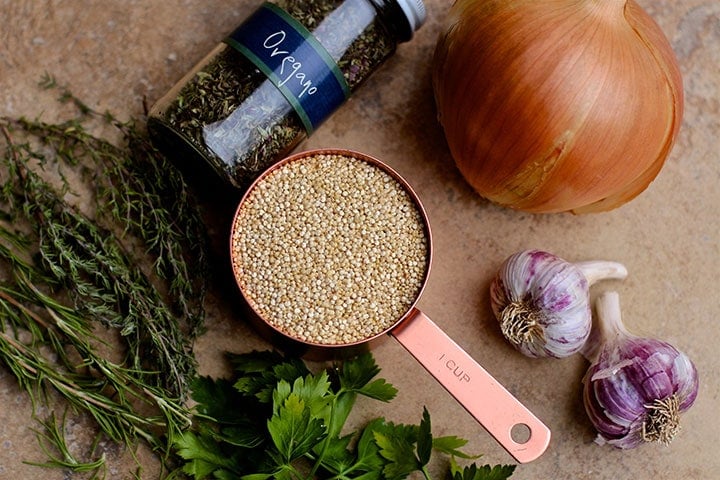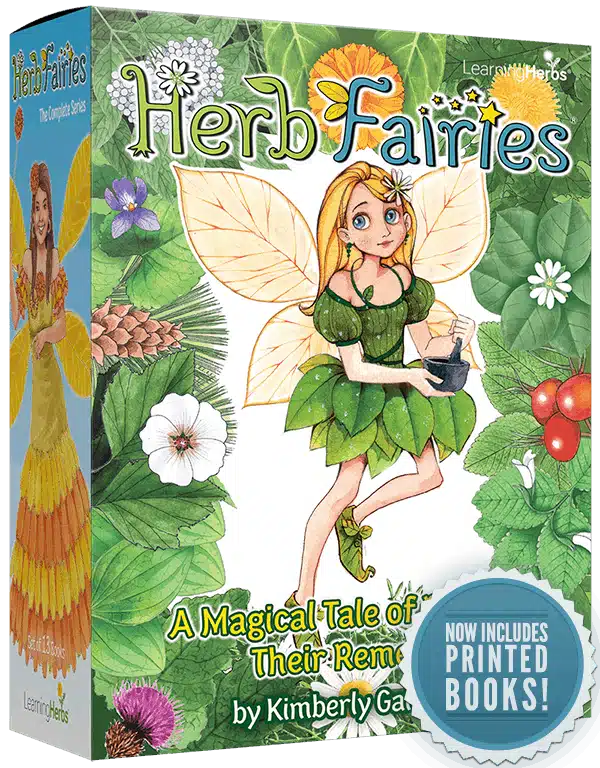Are you suffering from a phytonutrient deficiency?
I promise you – it’s a thing!
Let me explain. Compared to our ancestors, many of us eat a very bland diet that is comprised of a limited variety of foods. Eating the same few foods over and over again creates a sort of metabolic rut that is lacking in diversity. Herbalist Guido Masé points out that this leaves our cells starving for the signals they need to operate correctly and we end up with a “plant deficiency syndrome” or a phytonutrient deficiency.
Luckily there is a simple solution.
Eating an abundance of herbs and spices is an easy and delicious way to both enliven our foods and create a more complex diet. The intricate constituents found in medicinal plants (e.g., herbs and spices) are converted through a myriad of metabolic pathways which stoke our digestion and rev up our immune system, thereby generally increasing our good health.
And it doesn’t have to be complicated!
I created this quinoa recipe a couple of months ago and have served it to dinner guests numerous times. And whenever I make it, guests ask me to share the recipe. That’s always a clue to me that it’s worthy of an article!
This recipe transforms your basic quinoa into a phytonutrient-dense and delicious side dish.
Before we get to the quinoa recipe, here’s a look at our ingredients.

Quinoa
Quinoa is a nutrient-dense seed from the plant Chenopodium quinoa (a related species to lamb’s quarters or Chenopodium album). Even though this is a seed, we prepare and eat it like a grain (similar to rice).
Quinoa is high in plant proteins and it contains all nine essential amino acids. It is also high in manganese, fiber, magnesium, phosphorus, and folate. It contains antioxidants which contribute to free radical scavenging. 1
Quinoa also has saponins (soap-like constituents), which act as an anti-nutrient and generally should be avoided. To dramatically reduce the saponin content, it is recommended to rinse the quinoa well before cooking. Roasting it before cooking also removes any slightly bitter tastes left by the saponins.

Thyme and Rosemary and Oregano
These aromatic herbs are all in the mint family. They are also warming in nature and people commonly grow them throughout the world as culinary plants. Because they are ubiquitous, people often dismiss them as simple cooking plants, but these aromatic plants also are some of our best medicinal gems. All are strongly antimicrobial, wonderful for promoting digestion, and filled with complex phytonutrients.

Onions and Garlic
Onions and garlic are two of our most commonly eaten foods. These two plants are from the same genus (Allium) and both contain organosulfur compounds that give them their characteristic pungent taste and odor. These compounds have antioxidant qualities that studies show can support heart health and protect against cancer.234 They also promote healthy digestion and are delicious!

Parsley
The often ignored sprig of parsley on your restaurant dinner plate is another example of a plant loaded with beneficial phytonutrients. Parsley’s aromatic and dispersive qualities are wonderful for promoting digestion. Parsley also offers lots of nutrients that are important for heart health, including folate and Vitamin K1.

Herbed Quinoa Recipe
This quinoa recipe is a delicious and simple side dish that adds a burst of herbs and phytonutrients to your meal. It’s also a very forgiving dish that you can easily adapt to your palate. You could try adding more garlic, or more oregano and less rosemary, or increase the onions and add some sage for a more earthy flavor. The point of the recipe is to enjoy delicious food while getting an abundance and diversity of phytonutrients.
What you’ll need…
- 1 cup quinoa
- 2 tablespoons olive oil
- 1 onion, sliced
- 3 tablespoons olive oil, divided
- 1 teaspoon salt
- 3 cloves garlic, minced
- 1 teaspoon dried oregano leaves
- 2 cups bone broth or vegetable broth
- 1 teaspoon dried thyme leaves
- 1 teaspoon dried rosemary leaves
- 1/2 cup fresh parsley leaves, chopped

Begin by removing the saponins from the quinoa. Put the quinoa in a fine mesh strainer and rinse under running water for a couple of minutes. Gently rub the quinoa with your hands. Drain and discard the excess water. Set this aside to further drain while you cook the onions.
Heat 2 tablespoons of olive oil on medium high heat in a medium saucepan.
Add the onion and sauté until it becomes translucent and then slightly browned. Add the quinoa and stir for two minutes until the quinoa is slightly toasted.
Push the quinoa and onions to the sides of the pan, creating a well in the center of the pan. Add the remaining 1 tablespoon of olive oil, followed by the garlic and freshly crushed dried herbs, sauté for 30 seconds, stirring frequently.
Add the broth and salt, stir well. Cover with a tight fitting lid and bring to boil, then reduce to a simmer.

Simmer for 20 minutes, while tightly covered. Avoid opening the lid to check on it.
Turn off heat, let stand for 5 minutes. Fluff with a fork. The quinoa should be moist, but not mushy or crunchy. There should not be anymore liquid at the bottom of the pan. If it’s either too hard or there is too much liquid, return to the stove and cook for another five minutes or until done.
Stir in the fresh parsley leaves.
Serve immediately.
Yield: Roughly 3 cups of quinoa or a side dish serving for 6 people











Going to try out the quinoa? You can print out the recipe card above. Enjoy!
I learned recently that Quinoa is not a good food for Gluten Sensitive people.
Why? I never heard this. I eat it all the time with no problem.
Thank you! We eat a lot of Quinoa and this looks delicious…and healthy too!
Looks great! All I would add is that garlic’s active compound allicin develops AFTER bruising/mincing…so for maximum benefit, specify in the recipe to always mince garlic first and let rest at least 10 minutes before sauteeing!
THANKS!
Alternative: instead of just quinoa, use a mix of quinoa, millet, and buckwheat groats. The buckwheat has a lot of fiber so go easy until your body gets adjusted to it. Also the buckwheat gives it an overall heartier texture.
Hi Lisa,
My understanding is that this is a great practice when you are eating raw garlic. But allicin is not heat stable so it doesn’t matter much when cooking it. Luckily there are many important constituents in garlic so eating both raw and cooked garlic has many health benefits. When using garlic specifically as an antimicrobial, then raw is best.
We eat quinoa almost daily fo breakfast. I make it with dried fruit and nuts. After cooking you can add fresh berries and a little almond milk. Delicious and nutritious!
How many carbs in serving size?
If you do a search for “quinoa nutrient profile” then you can see many different sites with nutrient breakdowns.
Love it
Sounds yummy! Thanks. =)
Looks good & do-able for anyone. No speciality items required and all available in just about every supermarket.
Thanks
I would add – soak the quinoa (after rinsing) for at least a few hours to overnight, and even better to sprout it – to neutralize the phytic acid that binds up nutrients in our body. I believe this goes for all grains. :)
The combination of thyme oregano and rosemary sounds yummy,,,,,,,,
Vegan and gluten free, – I eat quinoa one to two times a week, it is and easy to combine with most anything
Some of my favorite combinations:
* Mixed red1/4 and white 3/4 quinoa) brussle sprouts, kale and sesame oil and ginger
* as a tabouli with raw: celery, tomatoe, zucchini noodles, parsley, red and orange peppers, olive oil lemon rind, ginger and hempseed
* with steamed carrot, yellow zucchini, green beans, raw zucchini noodles, hempseed, raw mustard greens and olive oil
* in a ginger broth soup with a variety of mixed steamed vegetables red and orange pepper, yellow zucchini carrots kale, bok choi, raw zucchini noodles and coconut oil
* great for veggie burgers with a variety of vegetables and hempseed
I use my crock pot to cook quinoa with a variety of other grains like amaranth, sorghum, millet or teff, along with rolled oats; along with a generous scoop of raw coconut oil, then flavor with ginger and cinnamon, craisins and raisins. When it’s cooled enough I stir yogurt into it, then put it in small containers. Breakfast for a week!
How do we store quinoa? does it need refrigeration?
I have 2 bags which was bought 2 years ago kept in a pantry (not warm condition). Is it still possible to consume or should I toss it out?
Thanks
try sprouting a few of the quinoa seeds and if they sprout, they would still be usable and nutritious I believe.
I like quinoa! It is so good for you! I needed this reminder about its many benefits.
Thanks for this delicious looking recipe, Rosalee!
Marie
I used up the last of my quinoa to make this tonight, and more’s the pity, as it seems like I might not have any leftovers once I’m through with it! I donated blood yesterday, and since then I’ve felt more fatigued than I remember experiencing after previous donations. I thought of all the nutrients in this dish, and figured it might be the perfect thing to help my body recover. I made a few changes based on what I had (or didn’t have) in my pantry, as well as added a heaping helping of fresh herbs at the end, and it’s delicious! Next time I pick up quinoa, this will definitely be on the menu.